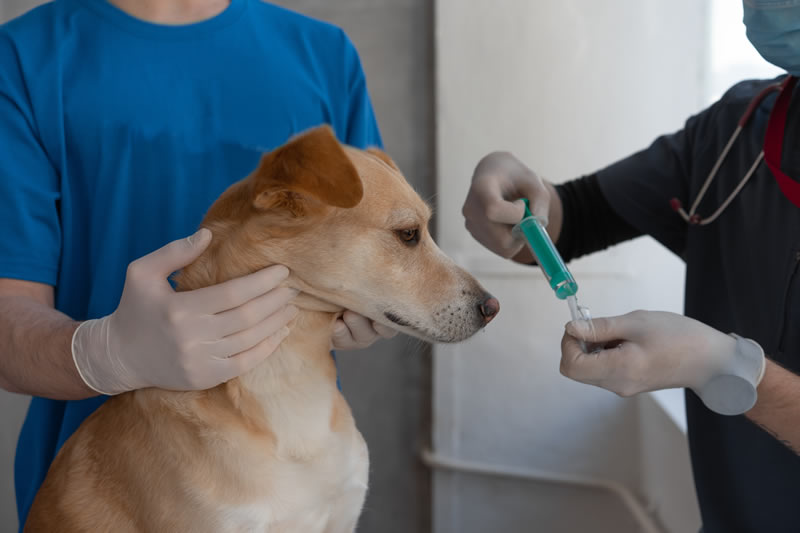Over the past two years, South Africa has experienced a worrying increase in dog rabies cases. Previously, the worst affected areas were the Eastern Cape and KZN. But last year, the rabies outbreak spread to all nine provinces.
Why should you be concerned about the rabies outbreak?
Rabies is a deadly viral disease, transmitted through the saliva of infected animals when they bite, scratch or lick another animal or person. Left untreated, rabies is fatal for both animals and people. Once the disease spreads to the brain and symptoms appear, there is no treatment or cure.
Any mammal can become infected – dogs, cats, livestock, wild animals and humans.
Increase in human rabies cases
In 2022, 13 cases of human rabies were reported in South Africa. This year, up until end June, six cases have already been reported [link https://outbreaknewstoday.com/south-africa-reports-6th-human-rabies-case-of-2023/] – three in the Eastern Cape, two in KZN and one in Limpopo.
Authorities suspect that the actual numbers may be higher, as the disease may not be correctly diagnosed – especially in rural areas where those affected don’t seek medical help.
Most human rabies cases result from being exposed to a rabid domestic dog. Young children are particularly vulnerable because they are unaware of the danger and more likely to approach and pet stray dogs.
If you have been bitten by an animal that may have rabies, wash the wound well with soap under a running tap and contact your doctor immediately, or go to the hospital right away to receive preventative treatment. It’s crucial to start treatment immediately, before any symptoms appear.
People at increased risk of exposure to rabies, such as veterinary staff, wildlife handlers and animal welfare staff, should be regularly vaccinated against the disease.
Notifiable disease
In South Africa, rabies in animals is a notifiable disease under the Animal Health Act 7 of 2002. [link https://www.gov.za/sites/default/files/gcis_document/201409/a7-02.pdf ] Suspected cases are usually based on signs and symptoms. Dogs that have not already died are euthanised to prevent the spread of the disease.
Private veterinarians, welfare organisations and the municipal dog control unit must report suspected cases to the state veterinarian. Carcasses are sent to the OIE Rabies Reference Laboratory at Onderstepoort for testing.
Human rabies cases are also notifiable. They are reported under different legislation to The National Institute for Communicable Diseases (NICD)
Tragedy of rabies
Although there is no cure, the real tragedy of rabies is that it is completely preventable. Rabies has been eliminated in many countries through systematic vaccination programmes for dogs. Unfortunately, in South Africa there are not enough resources for a uniform and complete rabies vaccination rollout.
Dogs need to be vaccinated when they are puppies (at four months) and then again when they are one year old. Animals must be vaccinated every year.
Vaccination of dogs and cats is mandatory by law in South Africa. It’s the pet owners’ responsibility to ensure vaccinations are up to date. This not only protects individual pets, but also helps control the spread of rabies within communities.
However, according to the Community and Veterinary Services for South Africa, only 15% of animals are regularly vaccinated against rabies.
What is causing the latest rabies outbreak?
- Large numbers of stray animals, particularly dogs, increase the likelihood of a rabies outbreak.
- Low vaccination rates among pets leave them susceptible to rabies and increase the risk of transmission to humans.
- Inadequate State or subsidised vaccination programmes for pets belonging to those who cannot afford private veterianary care.
- Lack of awareness – people don’t understand the need for regular vaccinations, or the potential dangers of rabies.
Preventing the spread of rabies
Last year, the Durban & Coast SPCA vaccinated over 6 000 dogs and cats. In addition, we sent 200 suspected rabies animals for testing, of which 52 were confirmed positive. This accounts for 14% of animal rabies cases in the entire KZN province.
How you can help
- Make sure all pets’ vaccinations are up to date.
- Spay or neuter pets to prevent the number of unwanted and stray animals.
- Keep pets within securely fenced areas to reduces encounters with infected animals. However, don’t use the excuse that, ‘my dog never leaves my property’ as a reason to skip vaccinations – your pet could be at risk from a stray cat, dassie, mongoose, or even a bat with rabies.
- Report suspected cases: If you suspect a case of rabies in an animal, report it to the local authorities or animal control agencies immediately. Prompt action can help prevent further transmission.
- Avoid contact with animals, especially stray dogs, cats and monkeys. Teach your kids to be wary of approaching unknown animals. Be aware that some animals can be infected with rabies without being aggressive or behaving strangely.
Look out for these signs and symptoms
Look out for unusual behaviour, especially aggression and unprovoked attacks. However, not all affected animals react this way. Some may become more lethargic, friendly, sleepy or unresponsive.
Drooling at the mouth is a common symptom, as nerve damage makes it difficult for the animal to swallow. Dogs may also bark, whine or howl.
If in doubt, consult your veterinarian, or call the SPCA. Remember, rabies kills. Don’t take chances.

